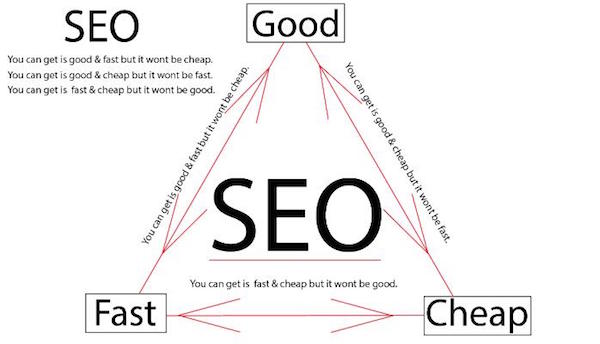Sustainable SEO Is Strategic, Not Tactical
A consumer-centric SEO strategy will deliver long-term business results.
When you’re creating a culture of digital business and trying to optimize for your audience online, none of the SEO concepts we talk about are autonomous. And they go much deeper than just face value.
This is why I stray away from the term SEO in the traditional sense. Because when we approach SEO strategically, we’re not optimizing for the search engines, we’re optimizing for our audience.
People want relationships. They want to know who they’re talking with when they’re buying, which is why it’s important to develop a profile that resonates with your audience.
Why A Strategic SEO Approach Beats A Tactical SEO Approach
This image brilliantly illustrates the differences between tactical and strategic SEO:

Image Credit: Matt Storms/LinkedIn
- You can get good and fast SEO results, but it takes commitment and resources.
- You can get good and cheap SEO results, but the results are going to be slow and ROI is going to take a long time.
- You can get fast and cheap SEO results, but when you get fast and cheap, you’re talking about tactics.
Tactics, as your foundation, run the risk of expiration in value when a search engine changes its algorithm.
Tactical SEO can work for a time, but it’s dangerous to invest in short-term tactics rather than embracing a consumer-centric strategy that can deliver real business results in the long term.
Digital marketing is no longer just technical. Digital marketing is the alignment of editorial to create awareness in an area in which sales is trying to target. It’s about identifying and building an audience with proper content.
Optimizing Keywords For Your Audience
A great place to start transforming your common SEO tactics is with your keyword research. Look at your research from an audience optimization view versus a search engine perspective.
Let’s say you do in-house marketing for a national house paint manufacturer, and you’ve launched a campaign to optimize for your products online.
Your team has put in all the legwork on your keyword research. They’ve used keyword tools, they’ve looked at your website’s referring keywords in analytics, compiled data from Google Trends, and so on.
You created a robust, nicely organized keyword list that has all your branded terms, head terms, and long-tail terms.
You and your team have done your best. But it’s still only your best guess. And that’s OK – initially.
There’s one problem. Your team presumed that if people needed paint for their homes, the keywords they would use in their queries would be related to buying paint.
But what your team didn’t know is that the interest for your product actually began generating long before the “buy” part, when your target audience began thinking in terms of home remodeling.
Keyword research solely with search traffic in mind leads to one-dimensional content. It doesn’t touch your audience at every stage of the purchase cycle, and it doesn’t speak to them.
Your team may have been able to uncover additional opportunities to connect, had they gone beyond the traditional keyword research.
If they had worked harder to get into the minds of the audience, the resulting keyword set and content would be much richer.
Luckily, keyword research and other SEO components are iterative processes that improve over time. They become better the more you listen and the more you engage with your community.
Watch Out For Task Lists As Solutions
If SEO consultants or agencies are selling you task lists of things you need to do to “be optimized,” you’re buying a tactical approach versus strategic.
The tactical/technical side of SEO, without the robust content components, is like putting dirty gas in a great automobile. You’re going to get terrible mileage.
Don’t get me wrong; we all have to start somewhere. But, there is no one set of tasks you can do that will save the day within your digital business plan, and then be done for good.
And if you keep following this same task list, it’ll get you nowhere. Insanity is repeating the same thing and expecting different results.
Digital business is not linear; it’s systematic. It’s an evolutionary loop.
After the first cycle of optimization, your business needs to be able to take all the data from every department, all the things you’ve learned, all the mistakes you’ve made, and all the wins, and apply them to the next cycle of SEO, where you essentially start over again.
In the digital business realm, improvements never end. You need to make sure you’re having smart conversations about multiple metrics to assess the success of your content, and your social visibility and engagement.
Being Strategic Means Being Flexible
Today, most companies aren’t yet ready for this digital transformation. Companies must embrace this change from the top down – to engage employees, change their perspective, and enable the differences between business units to the advantage of the company, rather than continuing to silo them.
To stay relevant, companies must be flexible enough to embrace change. You’ll see companies at a standstill when departments become too attached to their way of doing things – and that includes the way they view SEO.
Don’t be left behind with old technology, old ways of doing things, old tactical approaches while your competition embraces the future.
When you think strategy, it’s not just about how you will get there – it’s about how you will be among the first to get there and stay there.
Key Takeaways
- Take a look at the “why” behind the search engine optimization tactics you perform to get at the heart of their purpose.
- There is no “one set of tasks” that will save the day within your digital business plan. Digital business is not linear; it’s an evolutionary loop.
- Living within tactics creates a standstill approach while your competition embraces the ever-changing future.